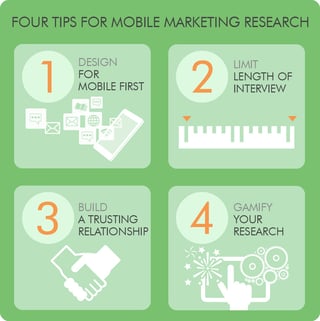Mobile phones provide an ideal method to collect and understand consumer behavior. Given their ability to capture real time responses, there are endless opportunities with mobile market research that we can utilize or further develop. As researchers, to capture authentic and honest input, we must implement best practices. Marketing researchers need to think mobile and consumer, first.
From social media apps to text messaging, the average American spends one hour and 49 minutes in-app on their smartphone daily. What does this mean for marketing researchers? It means mobile devices play an increasingly important role in our research. We should consider not only the frequency consumers are using their mobile device, but who we’re trying to reach as well. Those difficult 18-24 year-old males you’re looking for to top off your project? There is a good chance you’ll find them on their phone faster than on a laptop. Now, put yourself in a respondent’s shoes. If there aren’t enough surveys for you to take, or the surveys you receive are challenging to view, will you stay active on the panel? Engaged? If researchers aren’t putting out enough surveys for the demographics more likely to use a mobile device over a computer, we could see capacity decrease over time. Because of these points and many others, we need to put more focus on utilizing mobile devices to reach our target audiences and create surveys that are enjoyable to take on those devices.
Here are four best practices to apply:
- Design for Mobile First: While both PC and mobile can produce informative results, mobile provides real-time, in-the-moment data. Eighty-seven percent of U.S. smartphone users under 34 are never without their phones. What does this mean for marketing researchers? Build with the smallest mobile device in mind, then adapt for desktop.

- Limit Length of Interview: Quality results are impacted by the length of your survey. The use of mobile phones, globally, has expedited everything we do in the 21st century; including the amount of time to complete a survey on smartphones. While aesthetics are a huge part of delivery, make your surveys short and to the point. Surveys that are as short as possible, never exceeding 15 minutes, will yield a more attentive audience.
- Build a Trusting Relationship: Panelists are people and they now understand the value of their personal data, their opinions, and their time. Assure your respondents that their personal information will not be shared. Consent is essential; however, this is an obstacle for many marketing research companies. Capture data that is insightful, not invasive.
- Gamify Your Research: Gamifying research can result in dramatically higher levels of engagement amongst panelists (3x higher) and should be incorporated more frequently in survey design. Marketing researchers don’t need an overhaul of their research solutions; they can simply form the questions in a more engaging way. There are now many avenues to pursue when marketing to the modern world and many distractions to overcome. Be the distraction by gamifying your research.
RESEARCH TODAY REQUIRES MEETING CONSUMERS ON THEIR DEVICES.





